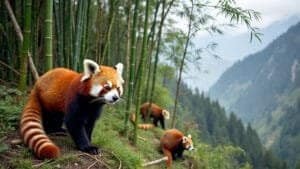Introduction
Red pandas, known for their striking appearance and unique dietary habits, play a vital role in maintaining forest ecosystems. Their foraging behaviors not only sustain their survival but also influence plant growth, particularly bamboo and other vegetation in their habitat
This article explores how red pandas’ feeding activities contribute to plant regeneration, biodiversity, and ecosystem stability
Topics include their impact on bamboo growth, seed dispersal, and the seasonal variations in their diet, highlighting their integral role in promoting forest health and biodiversity
The Foraging Habits of Red Pandas
Red pandas, native to the eastern Himalayas and southwestern China, are small, arboreal mammals with a diet primarily centered on bamboo
Despite their carnivorous classification, they have adapted to a predominantly herbivorous diet, which significantly impacts the ecosystems they inhabit. Their foraging habits are integral to understanding their role in plant growth and forest dynamics
What Plants Red Pandas Eat
Red pandas primarily consume bamboo leaves and shoots, which constitute about 90% of their diet. In addition to bamboo, they supplement their diet with fruits, berries, mushrooms, and occasionally small insects
This dietary diversity reflects their adaptability to seasonal changes and resource availability. The selective foraging of bamboo by red pandas helps manage the growth of dominant bamboo species, which might otherwise outcompete other plants in the ecosystem
Studies by Wei et al. (1999) emphasize that red pandas show a preference for specific bamboo species, particularly those that are tender and nutrient-rich
How Red Pandas Forage in Their Habitat
Foraging behaviors in red pandas are meticulous and deliberate. They are primarily active during dawn and dusk, utilizing their sharp claws and semi-retractable thumbs to climb trees and strip bamboo leaves efficiently
Their foraging is limited to areas within their home range, ensuring they do not overexploit a single area. This spatial distribution of feeding activities helps prevent localized overgrazing and promotes the even distribution of plant regeneration
Research from Pradhan et al. (2001) highlights how red pandas’ climbing and feeding patterns impact forest structure, as their activity often creates microhabitats for other species
Feeding Behaviors and Forest Interaction
The interaction between red pandas and their forest environment goes beyond mere consumption. As they move between feeding sites, they trample certain plant species while selectively foraging others, inadvertently influencing the composition of plant communities
Their consumption of fruits and berries aids in seed dispersal, as seeds often pass through their digestive system and are deposited elsewhere in nutrient-rich scat. Wallace and Black (2020) found that this process enhances forest diversity and promotes regeneration of fruit-bearing trees and shrubs, contributing to a balanced ecosystem
Red pandas’ foraging activities exemplify a delicate balance between their survival needs and ecosystem health, making them a keystone species in their habitat. Their habits ensure a continuous cycle of growth and regeneration, critical for sustaining the biodiversity of their forest homes
The Role of Red Pandas in Bamboo Growth
Bamboo, the staple diet of red pandas, is not only critical to their survival but also heavily influenced by their foraging activities
As red pandas selectively consume bamboo, their feeding behaviors contribute to both the regulation and regeneration of bamboo forests. This interplay between foraging and plant growth underscores the ecological importance of red pandas in maintaining forest health
Red Pandas’ Dependence on Bamboo
Red pandas rely on bamboo for the majority of their caloric intake, consuming its leaves, shoots, and stems. Their physiological adaptations, such as strong jaw muscles and an extended wrist bone functioning as a pseudo-thumb, allow them to efficiently strip bamboo leaves and access young shoots
According to Wei et al. (1999), red pandas exhibit a preference for certain bamboo species, such as Yushania and Phyllostachys. These preferences ensure the survival of non-preferred bamboo varieties, maintaining a balanced growth dynamic among bamboo species
How Foraging Stimulates Bamboo Regeneration
Red pandas’ foraging behavior promotes bamboo growth by naturally pruning the plants they consume. By eating older, mature leaves and shoots, they stimulate the production of fresh, tender growth
This regenerative process enhances the overall vitality of bamboo forests, ensuring a steady food supply for the pandas and other species that depend on bamboo
Furthermore, bamboo rhizomes (underground stems) are less likely to deplete soil nutrients when regularly pruned through natural foraging, as highlighted in a study by Bisht et al. (2022)
Challenges in Bamboo Conservation
Despite their role in promoting bamboo growth, red pandas and their habitat face significant threats from deforestation, climate change, and human encroachment. The fragmentation of bamboo forests disrupts the foraging patterns of red pandas, limiting their ability to contribute to bamboo regeneration
Additionally, certain species of bamboo are highly sensitive to environmental changes, making them vulnerable to extinction. Conservation efforts, such as reforestation and habitat protection, aim to preserve the delicate relationship between red pandas and bamboo ecosystems
The symbiotic relationship between red pandas and bamboo highlights the interconnectedness of species and their environments. By consuming and indirectly cultivating bamboo, red pandas sustain not only their own survival but also the health and biodiversity of the forests they inhabit
Seed Dispersal and Ecosystem Impact
Red pandas play a pivotal role in their ecosystems through seed dispersal and other indirect contributions to plant growth
As frugivorous feeders alongside their bamboo diet, their foraging behaviors support the regeneration of forest vegetation, aiding in biodiversity and ecological balance
Seed Dispersal Through Scat
When red pandas consume fruits and berries, the seeds often pass through their digestive system intact, eventually being excreted in different locations. This process is essential for the propagation of plant species across the forest floor
According to research by Wallace and Black (2020), the nutrient-rich scat of red pandas provides an ideal environment for seed germination, effectively supporting the regrowth of native vegetation
Species such as wild cherries and various berry-producing shrubs have been observed to benefit from this natural dispersal mechanism, contributing to forest diversity
Promoting Biodiversity via Foraging
By selectively foraging on certain plants, red pandas prevent dominant species from monopolizing forest resources. This behavior enables less competitive plants to thrive, thereby fostering a more diverse and resilient ecosystem
In their natural habitat, red pandas’ movements between feeding sites create patterns of disturbance that encourage plant succession—a process that replaces older vegetation with newer growth
Pradhan et al. (2001) noted that such behaviors increase habitat heterogeneity, making forests more robust against environmental changes
Forest Regeneration Supported by Red Pandas
Red pandas indirectly promote forest regeneration through their role as ecosystem engineers. Their trampling of underbrush while searching for food creates microhabitats for seed germination and small organisms
This dynamic interaction contributes to the development of a multi-layered forest structure, supporting a wide range of flora and fauna. Furthermore, the decomposition of their scat adds organic matter to the soil, enhancing its fertility and supporting the growth of diverse plant species
These processes highlight the critical role of red pandas in sustaining the health and diversity of forest ecosystems. Through seed dispersal and other ecological contributions, they ensure the vitality of their habitats for future generations
Seasonal Variations in Red Panda Foraging
The foraging behaviors of red pandas are closely tied to the changing seasons, which influence their dietary preferences and the availability of resources. Understanding these variations provides insight into how red pandas interact with their environment and contribute to plant growth throughout the year
Dietary Changes Across Seasons
Red pandas adapt their diet according to seasonal changes in their habitat. During the spring and summer months, they primarily consume bamboo shoots and tender leaves, which are abundant and nutrient-rich
In the fall, they shift to fruits and berries, such as wild cherries and raspberries, as these become more available. During the winter, when bamboo shoots are less accessible, red pandas rely on tougher bamboo leaves and occasionally supplement their diet with small insects or mushrooms
This seasonal flexibility ensures their survival and minimizes over-reliance on a single food source, as observed in studies by Wei et al. (1999)
Effects on Plant Growth Cycles
The seasonal foraging habits of red pandas influence plant growth cycles in significant ways. For example, their consumption of bamboo shoots in the spring stimulates the plant’s regenerative capacity, as pruning promotes the growth of new shoots
During the fall, their preference for fruits aids in seed dispersal, ensuring the propagation of fruit-bearing plants. The timing of their dietary shifts aligns with key reproductive phases of many plant species, enabling red pandas to play a supportive role in maintaining forest productivity throughout the year
Habitat Shifts and Resource Availability
Seasonal changes also drive red pandas to move within their habitat in search of food
They may descend to lower altitudes in the winter, where bamboo is more accessible, and return to higher elevations during warmer months to forage on young shoots and fruits. This migratory behavior helps distribute their ecological impact across a broader area, reducing the risk of localized overgrazing
Pradhan et al. (2001) noted that these habitat shifts not only benefit plant regeneration but also help maintain a balance between red pandas and other herbivores sharing the same ecosystem
Seasonal variations in red pandas’ foraging behaviors demonstrate their adaptability and their critical role in supporting the natural cycles of plant growth. By aligning their diet with seasonal resource availability, they contribute to the sustainability and resilience of their forest environments
Conclusion
Red pandas, as keystone species, play a vital role in the ecosystems they inhabit. Through their selective foraging behaviors, they support the growth and regeneration of bamboo, promote seed dispersal, and maintain plant biodiversity
Their seasonal dietary shifts ensure balanced resource use and contribute to the natural cycles of forest regeneration. These behaviors not only sustain their survival but also enhance the health and resilience of their habitats
Understanding the ecological impact of red pandas highlights the interconnectedness of wildlife and their environments. Protecting red pandas and their habitats is crucial for preserving the biodiversity and stability of forest ecosystems, emphasizing their importance as both unique animals and vital contributors to ecological balance











